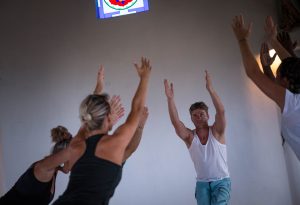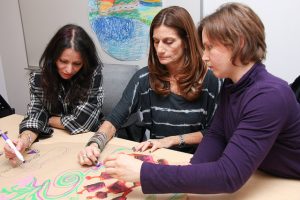
The negative symptoms of schizophrenia have previously been neglected as targets for treatment, despite carrying poorer long-term outcomes than positive symptoms such as hallucinations and delusions (Ho et al., 1998; Hunter & Barry, 2012; Lang et al., 2013). Negative symptoms, which include blunted emotion and anhedonia (difficulty experiencing pleasure), can have a profound impact on social and emotional functioning (Rabinowitz et al., 2012).
Few treatments for negative symptoms are available, and even fewer with a solid evidence-base (Elis et al., 2013). Arts therapies are the only treatment currently recommended by the National Institute for Health and Care Excellence (NICE) for alleviating negative symptoms (Bhugra, 2010). Still, the evidence base is rather thin, limited mostly to small-scale studies. Since the NICE guidelines were published, the first large randomised trial of art therapy was carried out, finding no significant effect on negative symptoms (Crawford et al., 2012).
Body psychotherapy is a type of art therapy based on a theory of body–mind functioning drawn from psychoanalysis, and is designed to improve emotional, cognitive, physical and social integration (Totton, 2005). A previous trial found that it reduced negative symptoms significantly, but had a small sample size and did not control for non-specific effects of physical activity (Röhricht & Priebe, 2006). Last month, the findings from a new multi-site randomised controlled trial (RCT) of body psychotherapy were published (Priebe et al., 2016).

Body psychotherapy is a type of art therapy based on a theory of body-mind functioning drawn from psychoanalysis.
Methods
Body psychotherapy helps patients explore a range of expressive and communicative behaviours with the aim of reducing emotional withdrawal and improving social functioning. The components of body psychotherapy under examination were the body experience at a cognitive and emotional level, and how movement links with emotion.
Twenty manualised group sessions of body psychotherapy were compared with an active control arm consisting of 20 Pilates sessions. This allowed for non-specific effects to be controlled for, such as group interaction, physical activity and attention from the facilitator. Each group was facilitated by an accredited therapist trained to deliver the manualised intervention, supported by a co-facilitator.
Participants were recruited from community mental health services in London, Manchester, and Liverpool. Inclusion criteria were: diagnosis of schizophrenia, 18–65 years old, a Positive and Negative Syndrome Scale (PANSS) negative subscale score equal to or greater than 18, and no change of antipsychotic medication for 6 weeks.
Outcome measures were taken at baseline, end of treatment, and 6 months after end of treatment. The primary outcome was the negative subscale of the PANSS, alongside secondary outcomes including general psychopathology, positive symptoms of schizophrenia, physical expression and experience, patient activity, and quality of life. A 20% reduction in the PANSS score was considered clinically significant.
Results
275 participants (predominantly white, male, unemployed, and living alone) were randomised, recruited between 2011-2013. There was good inter-rater reliability, meaning negative symptoms were scored similarly by all raters. There was relatively high attendance for both body psychotherapy and Pilates sessions.
The research team found a small reduction in mean PANSS negative symptoms between baseline and end of treatment for both groups (body psychotherapy group 1.5 (s.d.= 3.5); Pilates group 1.6 (s.d.= 3.8)). No significant difference was found between the experimental and control groups.
Regarding secondary outcomes, the only notable finding was a small but significant improvement in expression (vocal, facial, gesturing, etc.) and movement disorder symptoms at end of treatment. Movement disorder symptoms maintained a small improvement at follow-up.

Body psychotherapy did not have a clinically beneficial effect in the treatment of patients with negative symptoms of schizophrenia.
Discussion
No significant group differences between body psychotherapy and Pilates were detected regarding improvement in negative symptoms. There was an improvement in two secondary outcomes, namely expressive ability and movement disorder symptoms. However, these improvements yielded small effect sizes, implying a lack of a clinically meaningful benefit.
Large sample sizes maximise the chance of finding a significant group difference if one exists. That no differences were observed in this large, multi-site trial implies that body psychotherapy is not an effective treatment for the negative symptoms of schizophrenia. This is in contrast to a previous, smaller study which compared body psychotherapy with counselling (Röhricht & Priebe, 2006). Using Pilates as an active control, the current study likely controlled for non-specific treatment effects more appropriately.
It appears that what little benefit can be gleaned from body psychotherapy is non-specific, and could be conferred by similar group-based physical activities such as Pilates. This undermines the theory behind body psychotherapy, which involves an explicit conceptual approach, e.g. reconstructing a coherent ego structure through grounding and bodily awareness.
In the context of arts therapies as a whole, the findings contradict current NICE guidelines for the treatment of negative symptoms. However, the authors acknowledge that arts therapy is an umbrella term. Other large-scale RCTs should perhaps be conducted for other arts therapies (e.g. music therapy) before reaching a firm conclusion.
It is worth noting that this study, carried out by senior academics in the field, found a negative result and was published in a prestigious journal. We often hear about the bias towards publishing positive findings in academia. This publication bias is one of the principal factors contributing to the replication crisis in science (Ioannidis et al., 2014). This study is a good example of the benefit of pre-registering trials, an initiative intended to ameliorate this crisis. The current trial was registered on an online database ahead of data collection, and the study protocol detailing hypotheses, methods, and analyses was published three years ago (Priebe et al., 2013).
Conclusions
The authors conclude that:
Overall, this study does not support group body psychotherapy as a treatment for negative symptoms of schizophrenia. Reviewing the effectiveness of different arts therapy modalities separately may be informative to determine whether existing guidelines should be more cautious in recommending art and body psychotherapy specifically, or whether this extends to arts therapies as a whole.
Strengths and limitations
- Previous research in this area has been of low quality, using small sample sizes
- This large, multi-site trial had large samples and an appropriate active control arm to help control for non-specific effects
- There was high attendance and low attrition for both groups
- The authors indicate that while discouraged, emotional group interactions may have occurred in the Pilates group. Although the focus on body experience at a cognitive and emotional level may not be an explicit component of Pilates, implicit links may have been made by participants. Regardless, neither group was effective in producing change
- The authors concede that treatment was relatively short. It remains unclear whether more prolonged exposure would have a different outcome, but existing evidence suggests this is unlikely.

The evidence-base for arts therapies for mental illness remains relatively thin, but many service users report a positive impact of these interventions on their lives.
Links
Primary paper
Priebe S, Savill M, Wykes T, Bentall R, Reininghaus U, Lauber C, Bremner S, Eldridge S, Röhricht F. (2016) Effectiveness of group body psychotherapy for negative symptoms of schizophrenia: multicentre randomised controlled trial. The British Journal of Psychiatry, bjp. bp. 115.171397.
Other references
Bhugra, D. (2010). Schizophrenia, The nice guideline on core interventions in the treatment and management of schizophrenia in adults in primary and secondary care. National Collaborating centre for mental health.
Crawford, M. J., Killaspy, H., Barnes, T. R., Barrett, B., Byford, S., Clayton, K., Dinsmore, J., Floyd, S., Hoadley, A., & Johnson, T. (2012). Group art therapy as an adjunctive treatment for people with schizophrenia: multicentre pragmatic randomised trial. Bmj, 344, e846.
Elis, O., Caponigro, J. M., & Kring, A. M. (2013). Psychosocial treatments for negative symptoms in schizophrenia: current practices and future directions. Clinical psychology review, 33(8), 914-928.
Ho, B.-C., Nopoulos, P., Flaum, M., Arndt, S., & Andreasen, N. C. (1998). Two-year outcome in first-episode schizophrenia: predictive value of symptoms for quality of life. American Journal of Psychiatry.
Hunter, R., & Barry, S. (2012). Negative symptoms and psychosocial functioning in schizophrenia: neglected but important targets for treatment. European Psychiatry, 27(6), 432-436.
Ioannidis, J. P., Munafo, M. R., Fusar-Poli, P., Nosek, B. A., & David, S. P. (2014). Publication and other reporting biases in cognitive sciences: detection, prevalence, and prevention. Trends in Cognitive Sciences, 18(5), 235-241.
Lang, F., Kösters, M., Lang, S., Becker, T., & Jäger, M. (2013). Psychopathological long‐term outcome of schizophrenia–a review. Acta Psychiatrica Scandinavica, 127(3), 173-182.
Priebe, S., Savill, M., Reininghaus, U., Wykes, T., Bentall, R., Lauber, C., McCrone, P., Röhricht, F., & Eldridge, S. (2013). Effectiveness and cost-effectiveness of body psychotherapy in the treatment of negative symptoms of schizophrenia–a multi-centre randomised controlled trial. BMC psychiatry, 13(1), 26.
Rabinowitz, J., Levine, S. Z., Garibaldi, G., Bugarski-Kirola, D., Berardo, C. G., & Kapur, S. (2012). Negative symptoms have greater impact on functioning than positive symptoms in schizophrenia: analysis of CATIE data. Schizophrenia research, 137(1), 147-150.
Röhricht, F., & Priebe, S. (2006). Effect of body-oriented psychological therapy on negative symptoms in schizophrenia: a randomized controlled trial. Psychological medicine, 36(05), 669-678.
Totton, N. (2005). New dimensions in body psychotherapy: McGraw-Hill Education (UK).


Group body psychotherapy for negative symptoms of schizophrenia https://t.co/r6nYAzq6WC #MentalHealth https://t.co/768fgPG3GC
Today @RaphUnderwood on effectiveness of group body psychotherapy for negative symptoms of schizophrenia https://t.co/4y7JVQqSPl
@Mental_Elf @RaphUnderwood-can we dissociate non-specific & specific processes? Maybe non-specific processes depend on ‘specific’ tasks?
@StavrosOrfanos @Mental_Elf I agree, not easily determined. Also, active ingredient(s) of BP quite vague IMO https://t.co/Vu6fgtUwBg
@Mental_Elf thanks for writing this @RaphUnderwood again research with a predominantly male sample limits application to females….
Very true, forgot to list that in the shortcomings!!
@Mental_Elf @ian_hamilton_ V important point, and one we are currently attempting to address in a subgroup analysis.
RCT finds that body psychotherapy is not an effective treatment for negative symptoms of schizophrenia https://t.co/4y7JVQqSPl
Group body psychotherapy based on psychoanalysis for negative symptoms of schizophrenia ineffective https://t.co/xMMPqIcr7q via @sharethis
Morning @stefanpriebe @TilWykes @RichardBentall We’ve blogged about your #BodyPsychotherapy RCT https://t.co/4y7JVQqSPl
Many thanks both to the Elves and Raphael for your interest in our work! @Mental_Elf @RaphUnderwood
@Mental_Elf @TilWykes @RichardBentall Meta-analysis shows groups improve neg sx https://t.co/6Y6Lwi9Awk Maybe thats why BPT/Pilates helped?
No specific treatment for negative symptoms of #schizophrenia.
To avoid: 1) resocialization 2) don’t overmedicate. https://t.co/BIAoXPnC5y
@AllenFrancesMD @Mental_Elf So true and if Individual Placement & Support for vocational rehab were a drug, it would be billion dollar deal!
@Mental_Elf FAO @QMULSocialPsych
@AllenFrancesMD @Mental_Elf Maybe we think we need to think about ‘mode’ (groups vs 1:1), not ‘type’ of treatment? https://t.co/pmpFRKeftN
RCT finds little to support body psychotherapy for negative symptoms of schizophrenia https://t.co/4y7JVQqSPl
@Mental_Elf that is a surprise. Not
@RaphUnderwood @Mental_Elf Small reduction in expressive deficit may be important, since neg sx don’t easily shift! https://t.co/qolqj8pcoC
Have you benefitted from group-based physical activities to alleviate negative symptoms of schizophrenia? https://t.co/4y7JVQqSPl
Don’t miss: Group body psychotherapy for negative symptoms of schizophrenia https://t.co/4y7JVQqSPl #EBP
Group body psychotherapy for negative symptoms of schizophrenia https://t.co/n2MOTc1Lgy via @sharethis
“Body psychotherapie” tegen negatieve symptomen werkt niet. https://t.co/hXQpIcM7Yx
Group body psychotherapy for negative symptoms of schizophrenia https://t.co/t5pc5xTzuH
In addition: “a negative result and was published in a prestigious journal.” https://t.co/QXbfMMwXyG by @Mental_Elf https://t.co/Fjzqhperw1
@joarhalvorsen @paperbag1 This @Mental_Elf ‘s “psychoanalysis body therapy” paper discussion applies to any therapy. https://t.co/QXbfMMOyXg
Following publication of secondary analysis paper, demonstrating positive effect of body psychotherapy on negative symptoms in women (Savill et al. 2017; https://www.ncbi.nlm.nih.gov/m/pubmed/27871030/) and also given the fact that there was a significant effect on CAINS subscale in group of patients who do not otherwise respond to treatment the possibility of a therapeutic contribution of body psychotherapy in chronic schizophrenia should not be dismissed.